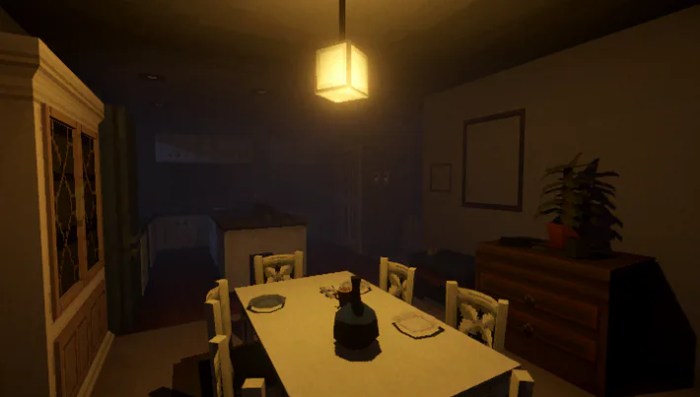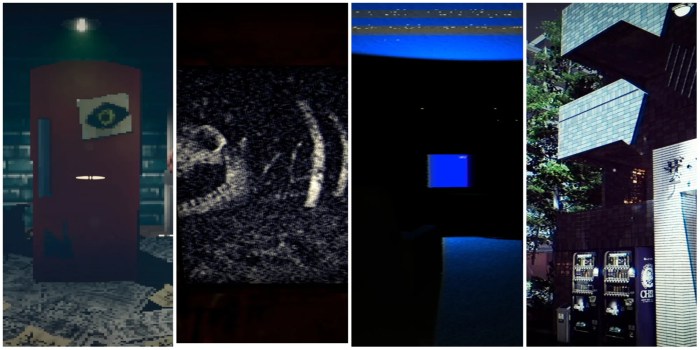Analog horror game survival mechanics and storytelling immerse players in a terrifying world where every choice, every resource, and every environmental detail contributes to the narrative. This exploration delves into the unique challenges and creative storytelling techniques employed in these physical games, contrasting them with their digital counterparts. From resource management to environmental storytelling, the physicality of the game profoundly impacts the player’s experience and shapes the narrative itself.
This exploration will unravel the core mechanics of analog horror games, examining how resource scarcity and environmental factors directly influence gameplay choices and the unfolding story. We’ll delve into the psychological impact of survival in a physical horror setting, highlighting the role of player agency and interaction in shaping the narrative. The discussion will conclude with design considerations for creating immersive analog horror experiences, emphasizing the unique challenges and opportunities of crafting a sense of dread and unease in a physical format.
Analog Horror Game Mechanics

Analog horror games, steeped in the tactile and tangible, offer a unique survival experience. The physicality of the game, relying on dice rolls, hand-drawn maps, and meticulously crafted props, immerses players in a world where resources are finite and decisions have tangible consequences. This tangible experience, far removed from the instantaneous feedback of digital games, forces players to truly consider their actions and the often unpredictable nature of the narrative.
The core mechanics of analog horror games revolve around resource management, environmental storytelling, and the inherent unpredictability of chance. Players must ration supplies, strategize their movements, and adapt to ever-shifting circumstances. The tactile nature of the game mechanics adds a layer of depth and immediacy, transforming a digital experience into a truly immersive and personalized one.
Resource Management in Analog Horror Games
Analog horror games differ significantly from their digital counterparts in their resource management systems. Digital games often provide a seemingly infinite supply of resources, enabling players to experiment and strategize without the fear of depletion. Analog games, however, impose a stark reality. Limited resources, whether it’s a dwindling supply of bandages or scarce fuel for a lantern, necessitate careful planning and calculated risk-taking.
Players must meticulously weigh their options, considering the potential consequences of their actions. For instance, a player might choose to prioritize a crucial repair over immediate escape if the consequences of failing the repair are catastrophic. This inherent scarcity forces players to prioritize and strategize their actions in a way that digital games often do not.
Resource Scarcity and Narrative Progression
The limited resources in analog horror games significantly impact gameplay choices and narrative progression. A dwindling supply of crucial items, such as flashlights or food rations, forces players to make tough decisions. They must decide whether to risk venturing into perilous areas or prioritize safety. These decisions directly shape the narrative, altering the character’s fate and the overall story’s progression. The game’s narrative becomes intertwined with the scarcity of resources.
A common example is the decision to risk a dangerous encounter to gather supplies or to prioritize immediate safety, potentially leading to missed opportunities or a more dire situation later. The lack of immediate “resupply” mechanisms emphasizes the weight of each choice.
Comparison of Resource Management Systems
| Game | Resource Gathering | Resource Management | Impact on Narrative |
|---|---|---|---|
| “The Last Transmission” | Gathering supplies from abandoned buildings or scavenging. Success dependent on dice rolls. | Rations, fuel, and repair materials are limited and directly impact player movement and safety. | Decisions about gathering or prioritizing safety impact the character’s fate, with choices potentially leading to a more or less terrifying end. |
| “Whispers in the Dark Woods” | Finding hidden caches or acquiring items from defeated enemies. Items are unique and have specific uses. | Maintaining health, morale, and light sources is critical, and scarcity creates high stakes. | The player’s ability to find and preserve items affects the story’s progression and the character’s ability to survive. |
Environmental Storytelling
Environmental storytelling plays a crucial role in analog horror games. Hand-drawn maps, meticulously crafted props, and the carefully chosen layout of the game’s environment act as a narrative tool, hinting at the game’s events and the history of the setting. The location’s atmosphere, from the crumbling ruins of a forgotten town to the eerie silence of a secluded forest, is crucial in creating the horror and the sense of dread.
For example, a torn map or a blood-stained diary could provide vital clues about the events that transpired. The physical environment is not just a backdrop but a crucial part of the narrative, conveying a sense of isolation, despair, and the potential for hidden dangers. The physicality of the game contributes to a deeper immersion and enhances the sense of suspense.
Survival in Analog Horror

The chilling grip of fear, the primal urge to survive – these are the cornerstones of analog horror games. Beyond the scares and jump scares, these games delve into the psychological depths of human resilience and the impact of a tangible, physical experience. This exploration delves into the nuanced aspects of survival in such environments, highlighting the profound effect of the game’s physicality on the player, the crucial role of agency, and the diverse challenges presented by varying scenarios.
Analog horror games, in their physicality, create a visceral connection between the player and the threat. This physicality, whether through the tactile weight of a game component or the deliberate movement of a physical object in a game, fosters a stronger sense of immersion. The sense of presence, amplified by the physical elements, fuels a more profound fear response.
Psychological Aspects of Survival
The psychological toll of survival in analog horror environments is multifaceted. The constant threat of the unseen, the limitations of resources, and the claustrophobic nature of the gameplay can induce a state of heightened anxiety and stress. Players experience heightened awareness and paranoia, often interpreting subtle cues and sounds as signs of danger. This heightened sensory perception, while useful for survival, can also lead to psychological exhaustion and even nightmares, mirroring the lasting impact of trauma in real-world scenarios.
Impact of Physicality on Player Experience
The physicality of the game plays a critical role in shaping the player’s experience. The tangible nature of objects, the act of physically searching for clues, and the deliberate movement within a limited space significantly impact the feeling of immersion and presence. The physical constraints of the game, such as limited movement or the need to use tools, can generate a sense of helplessness that contrasts with the agency players need to exercise. For instance, a game where you must physically roll dice to determine your character’s actions, rather than clicking on a screen, adds a layer of suspense and uncertainty that a digital game may lack.
Player Agency and Choice
Player agency in analog horror games is paramount. Choices made during the game, from the initial character setup to the decisions during encounters, have real-world consequences for the player’s survival. Each choice can trigger a different narrative trajectory, shaping the overall experience and impacting the player’s perception of their own resilience and vulnerability. The tangible nature of these choices reinforces the importance of strategic thinking and calculated risks.
Comparison of Survival Challenges Across Scenarios
Analog horror games offer a wide spectrum of survival challenges. Games set in abandoned houses might prioritize stealth and resource management, whereas those in remote forests might emphasize the player’s physical endurance and navigation skills. The psychological aspects also vary, with some scenarios focusing on the fear of isolation, while others may highlight paranoia and the fear of the unknown. A game focused on a haunted house might have limited space and resources, while a wilderness survival game might emphasize the dangers of nature and the need for survivalist skills.
Role of Player Interaction and Communication
In some analog horror games, player interaction and communication are essential for survival. Cooperation and trust between players are crucial in overcoming obstacles and managing resources. These elements are critical to maintaining mental and physical well-being in the face of a shared threat. The act of communicating through physical gestures, shared tasks, and shared decision-making can forge stronger bonds between players and strengthen their collective resilience. Conversely, a game that focuses on solitary survival can emphasize different psychological aspects of isolation and self-reliance.
Storytelling in Analog Horror Games: Analog Horror Game Survival Mechanics And Storytelling

Analog horror games, rooted in tangible experiences, weave narratives through the very act of playing. The physicality of the game, from the tactile weight of components to the limited resources available, becomes a crucial element in shaping the player’s understanding of the horrifying world they inhabit. This tangible approach, in contrast to digital experiences, fosters a unique sense of immersion and dread, often pushing players to confront the terrifying implications of their choices.
The limited resources and physicality of analog horror games become a powerful tool for narrative development. The scarcity of items, the necessity for strategic resource management, and the physical constraints of the game world all contribute to a sense of escalating dread. Players must carefully consider the implications of their actions, understanding that their choices are not just in-game decisions but are crucial threads in the unfolding story.
Narrative Mechanics in Analog Horror
The physical nature of analog horror games allows for a rich and layered storytelling experience. Game mechanics, such as the depletion of resources, the movement of characters across a board, or the drawing of cards, all contribute to a tangible sense of progression and peril. The unpredictable nature of dice rolls or card draws introduces an element of chance, further amplifying the sense of unease and the unknown.
Impact of Limited Resources
Limited resources, a fundamental aspect of analog horror, significantly impact the narrative. Players must make difficult choices about how to allocate their limited supplies. The scarcity of items forces strategic decision-making, adding depth to the narrative and making the game’s horrors feel more real. For example, a dwindling supply of bandages in a survival game could symbolize the dwindling hope of the protagonist, forcing the player to make critical choices about who to prioritize. This direct correlation between in-game resources and emotional weight elevates the horror to a new level, making the game’s narrative far more engaging.
Physicality and Enhanced Storytelling
The physicality of the game enhances the storytelling in several ways. The tactile experience of handling components, the clinking of tokens, or the shuffling of cards contribute to an immersive atmosphere. The weight of a character token, or the way a card feels in your hand, can heighten the sense of dread. A game that incorporates physical elements like sound effects, or a pre-designed soundtrack, creates a more immersive and atmospheric horror experience.
Narrative Structure and Components
| Game Mechanic | Narrative Contribution |
|---|---|
| Limited resources (e.g., bandages, food) | Symbolizes dwindling hope and the harsh realities of survival; forces strategic choices. |
| Character movement on a board | Visualizes the progression of the narrative; highlights the player’s position within the terrifying environment. |
| Card draws (e.g., encounters, events) | Introduces unpredictable elements and a sense of escalating danger. |
| Dice rolls | Introduce randomness into the game; adds a layer of suspense and uncertainty to player actions. |
| Physical components (e.g., tokens, cards) | Enhance the tactile experience; provide a tangible connection to the horror. |
Example of a Narrative Structure
Imagine an analog horror game where players control a group of survivors trying to escape a haunted mansion. The board represents the mansion’s layout, with different rooms and areas. Character tokens represent the survivors, and cards detail encounters, events, or resources. Dice rolls determine the outcome of these encounters. As the survivors explore the mansion, the limited resources (e.g., flashlights, ammunition, food) symbolize the dwindling hope and increasing danger. The physical act of moving tokens across the board, drawing cards, and rolling dice all contribute to a tangible and engaging narrative. The limited resources, coupled with the random events, creates a sense of impending doom, highlighting the importance of strategic decision-making and survival.
Analog Horror Game Design Considerations

Crafting a truly unsettling analog horror experience requires a meticulous approach, transforming the physical world into a tangible manifestation of dread. The tactile nature of these games demands a shift in perspective, moving beyond the digital screen and embracing the immediacy of physical interaction. This necessitates a careful balance between the narrative, player agency, and the inherent unpredictability of the physical world.
The core challenge lies in translating the intangible, the emotional resonance of fear, into tangible, physical components. A well-designed analog horror game must create a palpable atmosphere of unease, fostering a sense of vulnerability and paranoia in the player. This is achieved through carefully crafted narrative elements, strategic use of physicality, and a dynamic interplay of chance and player choice.
Challenges of Creating Immersive Analog Horror Experiences
Translating the immersive atmosphere of digital horror into a tangible format presents unique challenges. Analog horror games must rely on tactile cues, physical objects, and environmental design to evoke the same feelings of unease and dread. This often necessitates careful consideration of the player’s physical interaction with the game’s elements. Furthermore, the unpredictability of analog components, such as dice rolls or shuffled cards, must be woven into the narrative to ensure a unique and replayable experience. This can also introduce complications in ensuring consistent and predictable narrative flow.
Creating a Sense of Dread and Unease
Analog horror thrives on the ambiguity and unpredictability of the physical world. A sense of dread is cultivated by incorporating elements that induce anxiety and paranoia. This can be achieved through evocative sound design, carefully chosen materials that evoke a sense of decay or danger, and the use of limited information. For example, a creaking floorboard in a dimly lit room, coupled with a sudden, unexpected noise, can amplify the sense of foreboding. The narrative should subtly hint at a looming threat, leaving the player constantly on edge.
System for Generating Random Events
Random events are crucial to maintain narrative dynamism and unpredictable player outcomes. A system utilizing dice rolls, shuffled cards, or even pre-determined event cards can effectively introduce unexpected twists and turns. Each event should have varying degrees of impact on the player’s survival and the progression of the narrative. For instance, a roll of a dice could determine whether a monster appears, the location of a hidden object, or the nature of a hidden message. The randomness introduces a layer of replayability, as each playthrough could lead to a unique sequence of events. The events should be weighted to maintain an atmosphere of unease without being overly punitive or frustrating.
Utilizing Physicality to Enhance Suspense
The physicality of the game can amplify the suspense. For instance, heavy, weighted objects could represent a tangible sense of danger or oppressive atmosphere. Dimly lit areas, with the use of candles or flickering lanterns, can create a sense of foreboding. The player’s movement through the space and the sound of their actions (creaking floors, rustling leaves) can all be used to increase the feeling of isolation and dread. This relies on the player’s senses to contribute to the overall immersion.
Design Considerations Compared to Digital Counterparts
Analog horror games must confront the limitations of physicality, such as the difficulty in representing complex environments or nuanced characters. However, this also allows for a more intimate and tactile experience, with a focus on direct interaction and tangible feedback. Digital games can utilize elaborate graphics and sound effects, but the physical act of moving through a space and interacting with objects adds a layer of depth to the analog experience. Digital horror often relies on jump scares, whereas analog horror can use atmosphere and physical limitations to create a more pervasive sense of unease. The unpredictability of dice rolls and card draws creates a unique sense of agency that is difficult to replicate digitally. While digital games can offer intricate storylines and character development, analog games encourage a focus on the immediate experience and the unfolding mystery.
Environmental Storytelling in Analog Horror

The environment in analog horror games isn’t merely a backdrop; it’s a character in itself, weaving a tapestry of dread and suspense. Its decaying structures, unsettling details, and oppressive atmosphere work in tandem with gameplay mechanics to amplify the narrative, creating a truly immersive experience. This profound interplay is crucial for crafting a compelling horror experience.
The environment, in its physicality, directly contributes to the narrative’s atmosphere and emotional impact. A crumbling, overgrown mansion whispers tales of forgotten tragedies, while a stark, deserted forest echoes with the chilling silence of something lost. The subtle details – a misplaced photograph, a chipped inscription, a rusted key – become pieces of a larger puzzle, revealing fragments of the game’s history and the horrors it conceals.
How Physical Environments Create Unease
The physical design of a space is a potent tool in crafting fear. Dark, claustrophobic corridors, winding staircases, and dimly lit rooms evoke feelings of confinement and isolation, mirroring the player’s growing sense of vulnerability. Overgrown vegetation, grotesque sculptures, and decaying architecture can create a pervasive feeling of dread and unease, amplifying the psychological terror. The visual cues create a tangible sense of danger and decay, building suspense without relying solely on jump scares.
Player Interaction and Narrative Progression
The player’s actions directly influence the narrative through their interactions with the environment. Exploring a dilapidated house, finding a hidden room, or discovering a chilling clue in a forgotten corner all contribute to a growing sense of dread and the unraveling of the story. These interactions reveal hidden narratives and propel the player deeper into the game’s world, forcing them to confront the lurking horrors within.
Environmental Storytelling Design Table, Analog horror game survival mechanics and storytelling
| Environmental Element | Narrative Function | Example |
|---|---|---|
| Decaying structures | Symbol of past tragedy, isolation, and despair | A crumbling mansion, overgrown with vines |
| Hidden objects/locations | Clues to the story, hidden secrets, potential danger | A hidden diary, a secret passageway, a hidden room |
| Sound design | Evoke specific emotions, create tension, foreshadow events | Creaking floorboards, rustling leaves, chilling whispers |
| Lighting | Create atmosphere, highlight danger, enhance fear | Dim, flickering light, shadows, stark darkness |
| Temperature | Enhance the sense of unease, suggest danger | Cold, damp environment, sudden temperature drops |
A Uniquely Unsettling Environment: The Abandoned Asylum
Imagine a sprawling, overgrown asylum, its walls stained with faded, ghostly murals of patients. The air is thick with the cloying scent of mildew and decay. Broken windows offer glimpses into darkened rooms, where the echoes of tormented screams still seem to linger. Twisted metal railings, rusted and splintered, frame a gaping maw of a courtyard, where the wind howls a mournful dirge through skeletal branches. This desolate space is more than just a location; it’s a living embodiment of the horrors it contains. The eerie stillness is punctuated by the occasional creak of a swaying branch or the unsettling clatter of falling debris. This oppressive environment creates a tangible sense of danger and isolation, making the player feel truly lost and vulnerable within its confines. The decaying architecture, coupled with the chilling atmosphere, reinforces the game’s central theme of mental anguish and despair. The isolation within the asylum’s labyrinthine corridors and the eerie sounds further amplify the unsettling nature of the environment.
End of Discussion
In conclusion, analog horror games offer a unique and compelling approach to survival and storytelling. The physicality of the game, from the tangible resources to the meticulously designed environments, creates a deeply immersive experience that differs significantly from its digital counterpart. The intricate interplay of mechanics, player agency, and environmental storytelling elevates the narrative to a new level, demanding careful consideration of resources, choices, and interactions to overcome the horrors presented. The resulting experience is one of intense engagement and palpable tension.